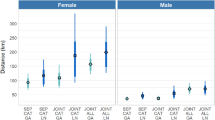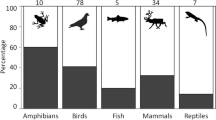Abstract
The work of this paper is motivated by a study of Great Cormorants, Phalacrocorax carbo sinensis, in Denmark. The dataset is complex, involving birds in different states living in and moving between neighbouring colonies. As a consequence, the set of probability models that might describe the data is large. In order to choose between the models, we present a score test approach for moving efficiently between the members of a model set with many members. We then provide a new measure for testing the absolute goodness-of-fit of the selected model to the data. This measure may be used when a model is multi-state/multi-site, and involves age- and time-dependence, as well as integrated recovery and recapture data, which is needed for the application. An illustration is provided by data from a single colony only, but with two breeding states, and an additional emigrated state.









Similar content being viewed by others
References
Arnason AN (1972) Parameter estimates from mark-recapture experiments on two populations subject to migration and death. Res Popul Ecology 13:97–113
Arnason AN (1973) The estimation of population size, migration rates and survival in a stratified population. Res Popul Ecology 15:1–8
Baillie SR, Green RE (1987) The importance of variation in recovery rates when estimating survival rates from ringing recoveries. Acta Ornithol 23:41–60
Barker RJ (1997) Joint modelling of live-recapture, tag-resight, and tag-recovery data. Biometrics 53:666–677
Barker RJ (1999) Joint analysis of mark-recapture-resighting and ring-recovery data with age-dependence and marking effect. Bird Study 46:S82–S91
Besbeas P, Borysiewicz RS, Morgan BJT (2009) Completing the ecological jigsaw. In: Thomson DL, Cooch EG, Conroy MJ (eds) Modeling demographic processes in marked populations. Environmental and Ecological Statistics, vol 3. Springer, Berlin, pp 513-539
Borysiewicz RS (2008) The combined analysis of multi-site mark-recapture-recovery and multi-site census data. PhD thesis, University of Kent
Burnham KP (1991) On a unified theory for release-sampling of animal populations. In: Chao MT, Cheng PE (eds) Proceedings of the 1990 Taipei symposium in statistics. Institute of Statistical Sciences, Academica Sinica, Taiwan, ROC
Burnham KP, Anderson DR (2002) Model selection and inference. A practical information-theoretic approach, 2nd edn. Springer, New York
Catchpole EA, Morgan BJT (1996) Model selection in ring-recovery models using score tests. Biometrics 52:664–672
Catchpole EA, Morgan BJT (1997) Detecting parameter redundancy. Biometrika 84:187–196
Catchpole EA, Morgan BJT, Freeman SN, Harris MP (1998) Integrated recovery/recapture data analysis. Biometrics 54:33–46
Catchpole EA, Morgan BJT, Freeman SN, Peach WJ (1999) Modelling the survival of British lapwings Vanellus vanellus using weather covariates. Bird Study 46:S5–S13
Catchpole EA, Morgan BJT, Tavecchia G (2008) A new method for analysing discrete life-history data with missing covariate values. J Roy Stat Soc B 70:445–460
Choquet R, Reboulet AM, Pradel R, Gimenez O, Lebreton JD (2004) M-SURGE: New software specifically designed for multistate capture-recapture models. Anim Biodivers Conserv 27:207–215
Choquet R, Lebreton JD, Gimenez O, Reboulet AM, Pradel R (2009) U-CARE: Utilities for performing goodness of fit tests and manipulating CApture-REcapture data. Ecography 32:1071–1074
Claeskens G, Hjort NL (2008) Model selection and model averaging. Cambridge University Press, Cambridge
Cole D (2011) Determining parameter redundancy of multi-state mark-recapture models for sea birds. J Ornithol (this issue)
Frederiksen M, Bregnballe T (2001) Conspecific reproductive success affects age of recruitment in a great cormorant Phalacrocorax carbo sinensis colony. Proc R Soc Lond B 268:1519–1526
Gaillard JM, Viallefont A, Loison A, Festa-Bianchet M (2004) Assessing senescence patterns in populations of large mammals. Anim Biodivers Conserv 27.1:47–58
Henaux V, Bregnballe T, Lebreton JD (2007) Dispersal and recruitment during population growth in a colonial sea bird, the great cormorant. J Avian Biol 38:44–57
King R, Brooks SP (2003) Closed-form likelihoods for Arnason-Schwarz models. Biometrika 90:435–444
Lebreton JD, Almeras T, Pradel R (1999) Competing events, mixtures of information and multistratum recapture models. Bird Study 46:S39–46
McCrea RS (2010) Closed form likelihood for an age and time-dependent multi-state mark-recapture-recovery model. University of Kent Technical Report. UKC/SMSAS/10/017
McCrea RS, Morgan BJT (2010) Multi-site mark-recapture model selection using score tests. Biometrics (in press). doi:https://doi.org/10.1111/j.1541-0420.2010.01421.x
McCrea RS, Morgan BJT, Gimenez O, Lebreton JD, Bregnballe T (2010) Multi-site integrated population modelling. J Agric Biol Environ Stat (in press). doi:https://doi.org/10.1007/s13253-010-0027-5
Morgan BJT, Palmer KJ, Ridout MS (2007) Negative score test statistic. Am Stat 61:285–288
Pledger S (2000) Unified maximum likelihood estimates for closed capture–recapture models using mixtures. Biometrics 56:434–442
Pledger S, Pollock KH, Norris JL (2003) Open capture-recapture models with heterogeneity: I. Cormack-Jolly-Seber model. Biometrics 59:786–794
Pradel R (2004) Multievent: an extension of multistate capture-recapture models to uncertain states. Biometrics 61:442–447
Pradel R, Wintrebert CMA, Gimenez O (2003) A proposal for a goodness-of-fit test to the Arnason-Schwarz multisite capture-recapture model. Biometrics 59:43–53
Rao CR (1948) Large sample tests of statistical hypotheses concerning several parameters with application to problems of estimation. Proc Camb Philos Soc 44:50–57
Read TRC, Cressie NAC (1988) Goodness-of-fit statistics for discrete multivariate data. Springer, New York
Rouan L, Choquet R, Pradel R (2009) A general framework for modelling memory in capture-recapture data. J Agric Biol Environ Stat 14:338–355
Schwarz C, Schweigert JF, Arnason AN (1993) Estimating migration rates using tag recovery data. Biometrics 59:291–318
Acknowledgments
We acknowledge the support of the EPSRC grant to the National Centre for Statistical Ecology and the helpful detailed comments of the anonymous referee.
Author information
Authors and Affiliations
Corresponding author
Additional information
Communicated by M. Schaub.
Rights and permissions
About this article
Cite this article
McCrea, R.S., Morgan, B.J.T. & Bregnballe, T. Model comparison and assessment for multi-state capture–recapture–recovery models. J Ornithol 152 (Suppl 2), 293–303 (2012). https://doi.org/10.1007/s10336-010-0611-z
Received:
Revised:
Accepted:
Published:
Issue Date:
DOI: https://doi.org/10.1007/s10336-010-0611-z




